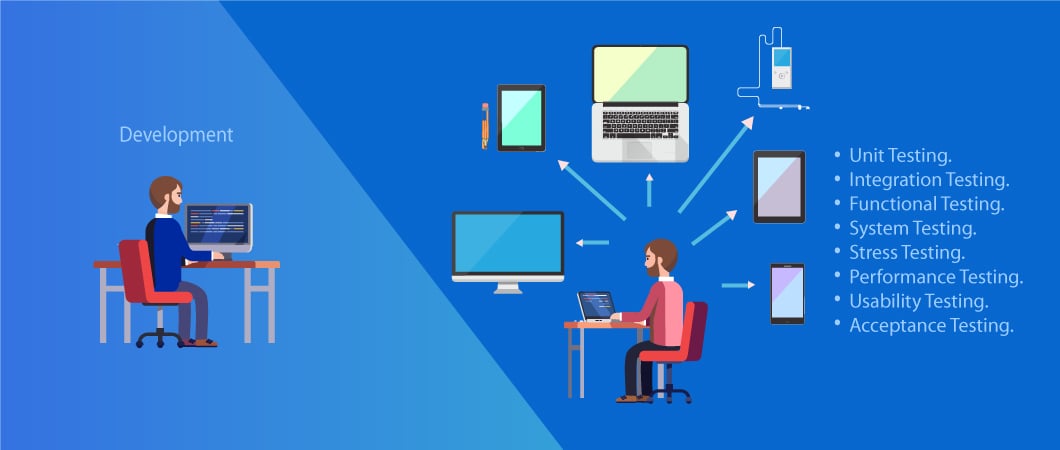You know that software testing is the process of evaluation of system components to find out if it fulfills all the requirements and that its main purpose is to find out bugs and defects, which ought to be rectified before the final product is rolled out. Surely you believe that early detection of issues in the software can help in saving considerable costs for the business and save time on rework. In the hierarchy of product development tasks though, do you sometimes feel that testing gets less of the spotlight than it deserves?
There’s a strong case to be made that this shouldn’t be the case. In fact, when you consider some of the key issues that are faced in software testing you may be tempted to say that testing may even be more difficult than software development.
Reiterating the importance of software testing
Software testing is critical as it helps in identifying errors and mistakes which might have been made during the development. Testing also helps in delivering a higher quality of product to the customers that deliver to their requirements, is easy to use, and glitch-free. With efficient testing processes, it’s possible to reduce the costs of maintenance. Besides, ensuring good performance of the product, software testing helps in ensuring that user requirements are being met. Clearly, software testing is absolutely critical to product success.
In the waterfall model days, testing used to be done at the end of the development cycle but in our more Agile times, greater emphasis is placed on testing throughout the development. The goal of every business is to reduce the go-to-market time and to ensure they get ample opportunity to bake in customer feedback into product iterations.
Top challenges in software testing
100% testing is impossible to achieve
There are so many different test combinations and scenarios that need to be taken into consideration while testing software applications. Besides, customers use different configurations across multiple platforms with varying hardware and software combinations. Given the time constraints, it is not realistically possible to test all the possible cases. Instead, having a clear focus on the requirements of the end-user and the business specifications makes prioritization a necessity. This element of judgment makes the testers task harder.
Quality assurance
It’s sometimes assumed that quality assurance is the responsibility of the testing team, but in reality, developers and testers need to be work together to achieve the business goals. Development can’t be held accountable for everything and testing alone cannot assure quality standards are met. Thus, the challenge. Both development and testing team must be tightly aligned and able to work together – an added element of complexity in the testing tale.
Confusion regarding the right type of testing
The need for speed creates the temptation to push automated testing over manual testing – but automated testing is not for all testing. Sometimes, it may not be possible to cover all the aspects using automated testing and a skilled and experienced tester will be required to complete the process. Choosing what to automate and what to trust to manual testing is a key decision not to be taken lightly.
Communication complexity
It’s essential to communicate the business requirements and the testing goals clearly right from the beginning of the product development – and then all the way through as well. Changes in the app or the requirements need to be communicated to the QA team on time. This is essential to ensure that the right functional requirements are being tested for. Unclear or delayed communications make it impossible to achieve business goals. The testing efforts may not yield the desired results – and not want to try.
What makes software testing more complicated?
Requires broader range of skills
Often, there is more emphasis laid on testing tools rather than developing core testing skills. This makes it difficult to find skilled testers. Testers must think from the perspective of the users and how they can use the application effectively and easily. Apart from traditional testing skills, they need to have strong attention to detail and must be able to think creatively to spot bugs and defects. Persistence is also key, as is the ability to adopt a structured approach and a questioning attitude.
Not much formal training
There are a few training courses that offer subjective knowledge about testing but many do not have practical, real-world applications. On the other hand, software development offers specialized courses for a specific technology where developers get a chance to master the key skills required for each language and technology. This provides them with greater flexibility to apply whatever they have learned and put it into practice.
Performance and interoperability issues
In case an application is designed to be used by many users at the same time, then it may be required to test the application under those conditions to ensure that each user gets the desired experience. These conditions are sometimes hard to predict, usually hard to recreate, and almost always hard to test for.
Conclusion
Ok, we’re not making the case that software development is not important in itself. We are also not saying that testing can exist in isolation of development, neither that it is a competition between testing and development. Brian W. Kernighan said, “Debugging is twice as hard as writing the code in the first place. Therefore, if you write the code as cleverly as possible, you are, by definition, not smart enough to debug it.” But we’re not prepared to go that far – just far enough to say that software testing is a critical skill –and that it deserves all the attention it gets, and more.



